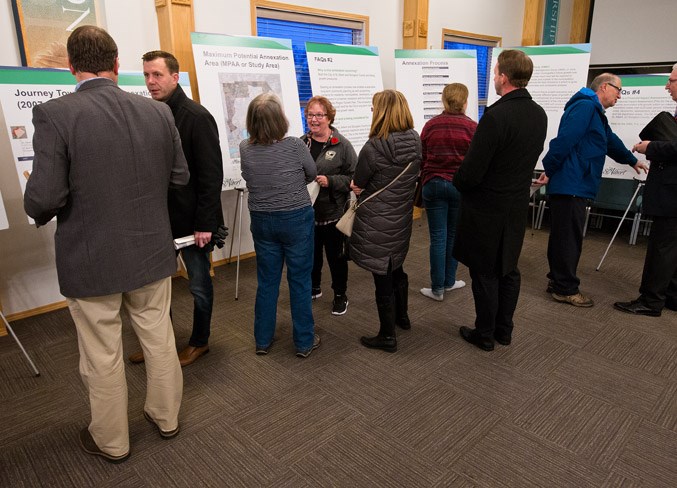Answers were in short supply this week as Sturgeon County residents came to open houses with questions on St. Albert’s plans to annex their land.
St. Albert and Sturgeon County officials held a series of open houses at Christ Community Church last week on the proposed annexation. About 50 residents and officials were at Tuesday night’s event.
If approved, the annexation would take up to 21.8 square kilometres from Sturgeon County – an area roughly twice the size of Morinville – and add it to St. Albert.
“We’re looking at a 50-year land supply,” said St. Albert planning branch manager Kristina Peter, one meant for a future where St. Albert has twice its current population.
Peter said this was the maximum amount of land on the table for negotiation, and some of it might stay in Sturgeon in the end. The city was studying the amount of land it actually needed, as well as the economic, infrastructure, transportation, agricultural and ecological implications of an annexation.
St. Albert last annexed land from the county in 2007 and is just now starting to develop it.
The city has about 10 years worth of available land now, and developers need time to build homes, said St. Albert Mayor Cathy Heron. This city is still growing, and we’ll need more land so that today’s kids have a place to live as adults.
“It’s for the next generation.”
These lands are better suited for urban growth, and Sturgeon wants to focus on rural development, said Sturgeon County Coun. Susan Evans, chair of the joint St. Albert/Sturgeon County annexation committee.
“The fact of the matter is that growth happens,” she said, and a joint, uncontested annexation will save everyone money on court fees.
“We’re not paying a lot of money to say, ‘No.’ We’re working together to make the best possible decisions for the future.”
Locals skeptical
Dan Cooper said he moved to the proposed annexation area from St. Albert because the county’s taxes were lower. Now, he predicts he’ll have to sell his land, as his acreage will be unaffordable at St. Albert’s tax rates.While it would be nice to be back on city water instead of a well, Cooper said he was concerned that he would lose access to the Roseridge Landfill if the annexation happened.
“Those little barrels they give you in St. Albert are not going to be enough to handle all the garbage I have.”
Wendy Miller, who lives just outside the proposed annexation area, said she was concerned development here would mean more traffic on rural roads, less farmland and an end her rural lifestyle.
“We’re going to be slowly consumed by St. Albert.”
Evans said she heard a lot of questions about taxes, services and roads at the open houses, all of which would be answered during future negotiations. She emphasized that this annexation was a 30-year vision, and that St. Albert would have to grow out from its current boundaries first.
“If you’re on the outer edge of what’s under consideration, you probably are not looking at change for 20 to 25 years.”
Heron said St. Albert would likely develop this region as a transition zone from the city to the county, much as has been proposed in the Sturgeon River Valley Special Study Area. Residents in it would see better fire, garbage and snow removal service, as well as higher property values once they joined the city.
“If you just want to sit and continue with status quo farming your lands, nothing will change,” she said – while this has yet to be determined, Heron said this annexation, like the 2007 one, would likely let landowners stay at county tax rates for about 10 years so long as they did not develop their property.
Evans said the committee would start negotiating the details of the annexation as soon as St. Albert finishes its studies. Those talks would likely take about two years to complete. After that, the province would still have to approve the annexation.
Expect more open houses on the annexation this spring, Peter said. Details and an online survey on the annexation are at bit.ly/2qB96Xz.




